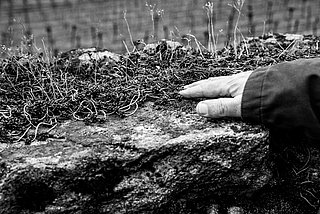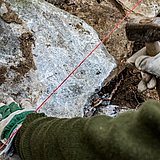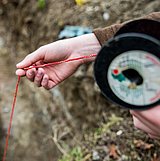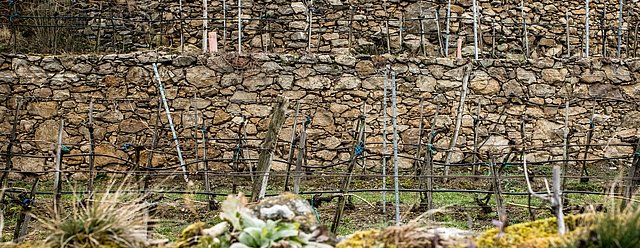![[Translate to Englisch:] (c) Pamela Schmatz](/fileadmin/_processed_/d/2/csm_druck_PamelaSchmatz-13_8d244b9c9a.jpg)
They create space. They provide support. They shape the landscape and make it possible for any wine at all to be grown on steep slopes: the dry stone walls of the Wachau.
Imagine ... the Wachau had no dry stone walls. There would not be any terraced vineyards. And no Wachau wines as we know them. Would the Wachau be an attractive destination for day-trips and holidays? One thing is for certain: it would look very different.

Stone on stone – nothing else
No mortar or other material is used to hold dry stone walls together. They are built simply of stones set one on top of another. Mostly paragneiss, marble and Gföhl gneiss are used in the Wachau. Smaller stones are used to fill the gaps between larger ones and to ensure stability. It all depends on getting the combination right. A skilled mason knows the best place for each stone. And which has a “face” – the most handsome stones are for the front row.
To be used in a dry stone wall, a stone has to meet special requirements, some of a technical nature – it must be of fissile rock, have a smooth surface and stand up to weathering. And it should cost as little as possible. The best to use are stones from nearby. Wine growers gather such stones year-round to build their walls in winter. The material for new dry stone walls often comes from caved-in structures or abandoned vineyards. Whatever else is needed is purchased from local quarries. Selecting stones requires keen judgement, to pick just the right colour; usually a warm, greyish-brown shade looks best.
Three million square metres of dry stone wall
Over 40 per cent of the Wachau’s vineyards are planted on terraces – supported by roughly 2.5 to 3 million square metres of dry stone walls. Without them, growing grapes would be impossible on the many of the Wachau’s slopes that are too steep to be worked by hand or machine. Terracing has another advantage, preventing erosion of the thin but fertile layer of humus covering the bedrock in this area: terraces hold back the soil on the hills. Planting rows of vines vertical to the slope, as is done in other areas such as southern Styria, would not work in the Wachau. Terracing offers the only option for securing valuable vineyard area and making use of steep slopes with as much as 30° gradients. Walls also have the advantage of storing heat and water. This beneficially impacts the vineyard micro-climate.


The higher the wall, the sturdier the foundation needed. For a dry stone wall three metres tall, this rule means a foundation reaching about 75 centimetres below ground, as the lower third carries the most weight. The wall can then be narrower towards the top. It is obvious then that what we seen is merely one portion of the wall – its “face”. Hidden behind it are additional courses of stone that support the wall and ensure stability. An important consideration but often neglected when building a wall.
More than the sum of the parts
Just how much the dry stone walls shape the lives of Wachau residents can be appreciated when you consider how economic and ecological factors figure into the system as a whole. Dry stone walls are typical of the UNESCO Wachau World Heritage Site – and of the scenery awaiting tourists. Both the beauty of the terrace landscape and wine-growing are direct factors accounting for the region’s success in tourism and other industries.
While intact natural surroundings are an important prerequisite, the Wachau’s dry stone walls provide the country’s largest habitat for beneficial organisms. The walls are home to twice as many species as the vineyards, in fact, with slowworms, praying mantises, shrews and voles aplenty here. Broad-leaved thyme, birdsfoot trefoil and cypress spurge flourish here as well. The dry stone walls are also an important habitat for the green lizard, who lends its German name, Smaragdeidechse, to one of Vinea Wachau’s three brand labels: Smaragd® stands for the best, most esteemed wines produced by Vinea Wachau’s wine growers. Which brings us back to our first insight: a Wachau dry stone wall is not just any wall. And the whole is more than the sum of the parts.
